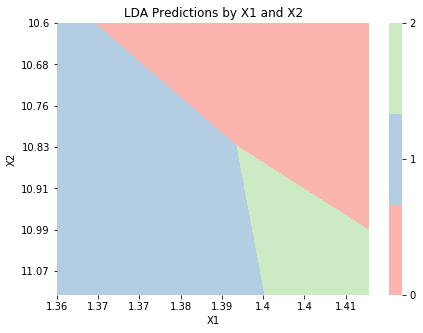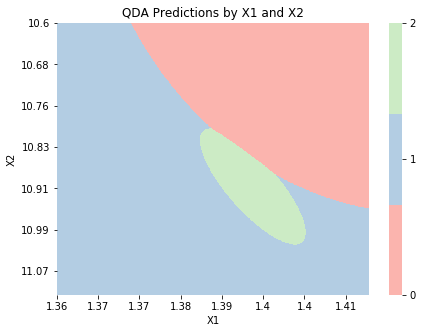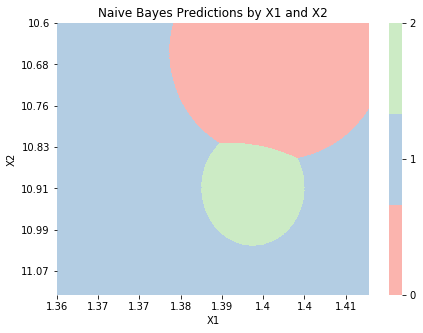Implementation¶
import numpy as np
import matplotlib.pyplot as plt
import seaborn as sns
from sklearn import datasets
wine = datasets.load_wine()
X, y = wine.data, wine.target
The code below shows scikit-learn implementations of LDA, QDA, and Naive Bayes using the wine dataset. Note that the Naive Bayes implementation assumes all variables follow a Normal distribution, unlike the construction in the previous section.
from sklearn.discriminant_analysis import LinearDiscriminantAnalysis, QuadraticDiscriminantAnalysis
from sklearn.naive_bayes import GaussianNB
lda = LinearDiscriminantAnalysis()
lda.fit(X, y);
qda = QuadraticDiscriminantAnalysis()
qda.fit(X, y);
nb = GaussianNB()
nb.fit(X, y);
Next, let’s check that these scikit-learn implementations return the same decision boundaries as our constructions in the previous section. The code to create these graphs is written below.
def graph_boundaries(X, model, model_title, n0 = 1000, n1 = 1000, figsize = (7, 5), label_every = 4):
# Generate X for plotting
d0_range = np.linspace(X[:,0].min(), X[:,0].max(), n0)
d1_range = np.linspace(X[:,1].min(), X[:,1].max(), n1)
X_plot = np.array(np.meshgrid(d0_range, d1_range)).T.reshape(-1, 2)
# Get class predictions
y_plot = model.predict(X_plot).astype(int)
# Plot
fig, ax = plt.subplots(figsize = figsize)
sns.heatmap(y_plot.reshape(n0, n1).T,
cmap = sns.color_palette('Pastel1', 3),
cbar_kws = {'ticks':sorted(np.unique(y_plot))})
xticks, yticks = ax.get_xticks(), ax.get_yticks()
ax.set(xticks = xticks[::label_every], xticklabels = d0_range.round(2)[::label_every],
yticks = yticks[::label_every], yticklabels = d1_range.round(2)[::label_every])
ax.set(xlabel = 'X1', ylabel = 'X2', title = model_title + ' Predictions by X1 and X2')
ax.set_xticklabels(ax.get_xticklabels(), rotation=0)
X_2d = X.copy()[:,2:4]
lda_2d = LinearDiscriminantAnalysis()
lda_2d.fit(X_2d, y);
graph_boundaries(X_2d, lda_2d, 'LDA')

qda_2d = QuadraticDiscriminantAnalysis()
qda_2d.fit(X_2d, y);
graph_boundaries(X_2d, qda_2d, 'QDA')

nb_2d = GaussianNB()
nb_2d.fit(X_2d, y);
graph_boundaries(X_2d, nb_2d, 'Naive Bayes')

